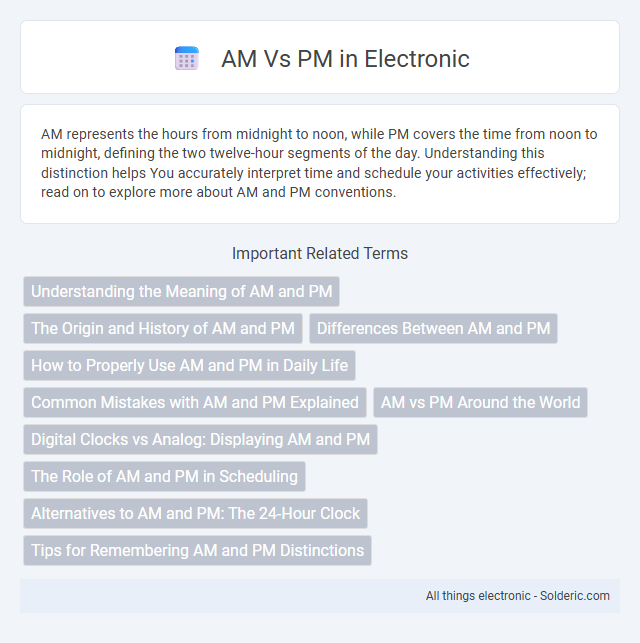AM represents the hours from midnight to noon, while PM covers the time from noon to midnight, defining the two twelve-hour segments of the day. Understanding this distinction helps You accurately interpret time and schedule your activities effectively; read on to explore more about AM and PM conventions.
Comparison Table
| Aspect | AM (Ante Meridiem) | PM (Post Meridiem) |
|---|---|---|
| Definition | Before noon (midnight to 11:59 AM) | After noon (12:00 PM to 11:59 PM) |
| Time Range | 00:00 - 11:59 | 12:00 - 23:59 |
| Usage | Indicates morning hours | Indicates afternoon and evening hours |
| 12-Hour Clock Label | Midnight to just before noon | Noon to just before midnight |
| Examples | 6:00 AM, 10:30 AM | 1:00 PM, 9:45 PM |
Understanding the Meaning of AM and PM
AM stands for "Ante Meridiem," meaning before midday, and refers to the hours from midnight to noon, while PM stands for "Post Meridiem," meaning after midday, covering the hours from noon to midnight. Understanding AM and PM is essential for accurately interpreting and scheduling time in the 12-hour clock system. Your ability to distinguish between these two markers ensures precision in daily activities, appointments, and time management.
The Origin and History of AM and PM
The terms AM and PM originate from the Latin phrases "ante meridiem" and "post meridiem," meaning before midday and after midday, respectively, reflecting their historical use in dividing the day into two 12-hour periods. This timekeeping system traces back to ancient Rome, where sundials indicated noon as the midpoint, necessitating a clear distinction between morning and afternoon hours. Over centuries, the AM/PM convention was standardized worldwide, shaping modern 12-hour clocks and influencing daily routines in various cultures.
Differences Between AM and PM
AM (ante meridiem) refers to the time from midnight to noon, covering hours 12:00 AM to 11:59 AM, while PM (post meridiem) spans noon to midnight, from 12:00 PM to 11:59 PM. The primary difference lies in the division of the 24-hour day into two 12-hour segments, affecting scheduling, timekeeping, and daily activities. Understanding AM and PM is crucial for accurate communication of your appointments and deadlines.
How to Properly Use AM and PM in Daily Life
To properly use AM and PM in daily life, understand that AM (ante meridiem) refers to times from midnight to noon, while PM (post meridiem) covers noon to midnight. When scheduling events or setting alarms, specify AM for morning activities, such as 7:00 AM for breakfast, and PM for evening activities, like 7:00 PM for dinner. Avoid confusion by using a 12-hour clock format clearly paired with AM or PM to distinguish between morning and evening hours.
Common Mistakes with AM and PM Explained
Common mistakes with AM and PM often stem from confusion between the 12-hour and 24-hour time formats, leading to scheduling errors. People frequently misinterpret 12 AM as noon instead of midnight and 12 PM as midnight instead of noon, causing miscommunication in appointments and events. Clarifying that AM refers to times from midnight to just before noon, while PM covers noon to just before midnight, helps prevent these timing inaccuracies.
AM vs PM Around the World
The distinction between AM and PM varies globally, with countries using the 12-hour clock format to separate morning (AM) and afternoon/evening (PM) hours. While the 12-hour system is common in places such as the United States and Canada, many nations in Europe, Asia, and Africa prefer the 24-hour clock format, eliminating the need for AM and PM designations. Understanding your location's time convention helps avoid confusion in scheduling and international communication.
Digital Clocks vs Analog: Displaying AM and PM
Digital clocks often display AM and PM indicators clearly, making it easy for you to distinguish morning and evening times at a glance. Analog clocks rely on the position of the hour hand and sometimes include a small AM/PM indicator or color coding but require interpreting the clock face in context. This distinction affects your ability to quickly understand time, especially in environments where precise differentiation between AM and PM is crucial.
The Role of AM and PM in Scheduling
AM and PM play a crucial role in scheduling by clearly dividing the 24-hour day into two distinct 12-hour periods, helping to avoid confusion in appointment times and daily planning. Using AM for times from midnight to noon and PM for times from noon to midnight ensures precise communication of events, meetings, and deadlines. Accurate use of AM and PM allows your schedule to run smoothly, preventing missed appointments and time-related errors.
Alternatives to AM and PM: The 24-Hour Clock
The 24-hour clock offers a clear alternative to AM and PM, eliminating confusion by numbering hours from 00 to 23. This system is widely used in military, aviation, and international contexts for precise timekeeping. You can easily convert your time format to the 24-hour clock for accuracy and global standardization.
Tips for Remembering AM and PM Distinctions
To easily distinguish AM from PM, remember that AM stands for "ante meridiem," indicating times from midnight to noon, while PM means "post meridiem," covering noon to midnight hours. Associating AM with morning activities like breakfast or sunrise can reinforce morning timing, whereas linking PM with evening events such as dinner or sunset aids in identifying afternoon and night hours. Using digital clocks with clear AM/PM indicators or converting times to 24-hour format reduces confusion in scheduling and time management.
AM vs PM Infographic

 solderic.com
solderic.com